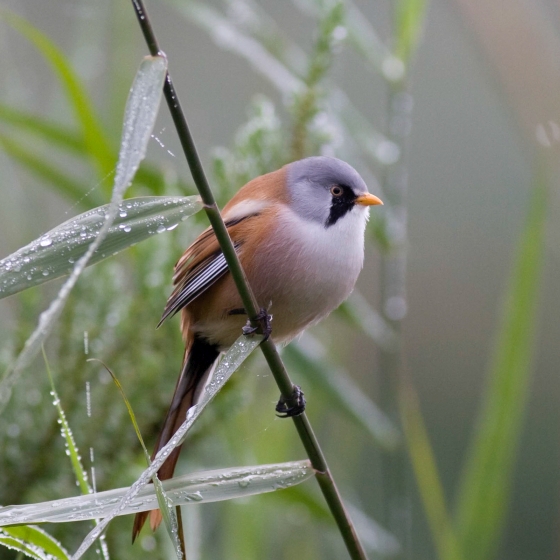Bearded Tit

Introduction
The extraordinary colours, shape and calls of this small, reed-dwelling bird are quite unlike any other British species. It is related only distantly to other tit species.
Bearded Tits can be found year-round in large reed beds across England, Wales and the Tayside area of Scotland. Their long tail, rich auburn plumage, grey head and black moustachial stripe (or 'beard') are distinctive. In autumn, birds may be seen 'feeding' on grit, which helps to facilitate their switch from a summer diet of reedbed insects to one mostly of reed seeds in the winter.
Bearded Tit numbers were severely reduced by long, cold winters in the 20th century, and the species became restricted to a handful of sites in East Anglia and Kent. The species has since increased hugely in both numbers and range, and appears less susceptible to hard weather.

Key Stats
Identification
Songs and Calls
Call:
Alarm call:
Flight call:
Young call:
Status and Trends
Conservation Status
Population Change
Bearded Tit is a specialist which breeds in reed-beds, and consequently many of its breeding sites are on nature reserves where they are well-monitored and reported to the Rare Breeding Birds Panel. The population is around 700 pairs (five-year mean of 673 pairs for the period 2015–2019) and has almost doubled over the 25 years to 2019 although annual fluctuations can occur due to severe winter weather (Eaton et al. 2021). The breeding range in Britain expanded by 84% between 1968–72 and 2008–11 and the species now breeds in both Scotland and Wales (Balmer et al. 2013)
Distribution
Bearded Tits are dependent on extensive Phragmites-dominated reedbeds and in 2007–11 they were found mostly in East Anglia and on the English south coast, with small isolated populations elsewhere, including in Wales and southern Scotland. Newly created or expanded reedbeds in Somerset, South Yorkshire and the East Anglian Fens have been readily colonised.
Occupied 10-km squares in UK
or view it on Bird Atlas Mapstore.
or view it on Bird Atlas Mapstore.
European Distribution Map
Distribution Change
The breeding range expanded by 40% between the 1968–72 Breeding Atlas and the 1988–91 Breeding Atlas. This pattern has continued with a further 32% range expansion by 2008–11
Change in occupied 10-km squares in the UK
or view it on Bird Atlas Mapstore.
or view it on Bird Atlas Mapstore.
Seasonality
Bearded Tit is recorded year-round; detections increase in autumn when irruptive parties can appear in atypical locations.
Weekly pattern of occurrence
The graph shows when the species is present in the UK, with taller bars indicating a higher likelihood of encountering the species in appropriate regions and habitats.

Movement
Britain & Ireland movement
Foreign locations of birds ringed or recovered in Britain & Ireland
Dots show the foreign destinations of birds ringed in Britain & Ireland, and the origins of birds ringed overseas that were subsequently recaptured, resighted or found dead in Britain & Ireland. Dot colours indicate the time of year that the species was present at the location.
- Winter (Nov-Feb)
- Spring (Mar-Apr)
- Summer (May-Jul)
- Autumn (Aug-Oct)

European movements
EuroBirdPortal uses birdwatcher's records, such as those logged in BirdTrack to map the flows of birds as they arrive and depart Europe. See maps for this species here.
The Eurasian-African Migration Atlas shows movements of individual birds ringed or recovered in Europe. See maps for this species here.
Biology
Productivity and Nesting
Nesting timing
Egg measurements
Clutch Size
Survival and Longevity
Survival is shown as the proportion of birds surviving from one year to the next and is derived from bird ringing data. It can also be used to estimate how long birds typically live.
View number ringed each year in the Online Ringing Report.
lifespan
Survival of adults
Biometrics
Wing length and body weights are from live birds (source).
Wing length
Body weight
Ring Size
Classification, names and codes
Classification and Codes
- Order: Passeriformes
- Family: Panuridae
- Scientific name: Panurus biarmicus
- Authority: Linnaeus, 1758
- BTO 2-letter code: BR
- BTO 5-letter code: BEATI
- Euring code number: 13640
Alternate species names
- Catalan: mallerenga de bigotis
- Czech: sýkorice vousatá
- Danish: Skægmejse
- Dutch: Baardman
- Estonian: roohabekas e. roovilbas
- Finnish: viiksitimali
- French: Panure à moustaches
- German: Bartmeise
- Hungarian: barkóscinege
- Icelandic: Kampameisa
- Irish: Meantán Croiméalach
- Italian: Basettino
- Latvian: bardzilite
- Lithuanian: usuotoji zyle
- Norwegian: Skjeggmeis
- Polish: wasatka
- Portuguese: chapim-de-bigodes
- Slovak: fúzatka trstinová
- Slovenian: brkata sinica
- Spanish: Bigotudo
- Swedish: skäggmes
- Welsh: Titw Barfog
- English folkname(s): Reedling, Ping Tit
Research
Causes of Change and Solutions
Causes of change
Bearded Tits depend on Phragmites reedbeds and therefore habitat availability is likely to limit their distribution (Balmer et al. 2013). The creation and restoration of reedbeds over the last fifty years to help other specialist species, such as Bittern, is therefore likely to have helped drive population increases. Bearded Tits may be affected by severe weather (e.g. Wilson & Peach 2006) so it is also conceivable that climate change may also have benefited the species.

